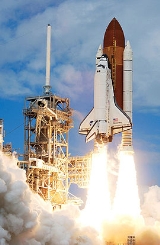
with modular add-ons. Major missions included launching numerous satellites and interplanetary probes, conducting space science experiments, and 37 missions constructing and servicing the International Space Station
. A major international contribution was the Spacelab
payload suite, from the ESA
.
Major components included the orbiters
, recoverable boosters
, external tanks
, payloads, and supporting infrastructureorchestrated by thousands of people on the ground and crewed by an elite cadre of astronauts.
The Space Shuttle was a partially reuseable launch system and orbital spacecraft
operated by the U.S.
1972 U.S. President Richard Nixon orders the development of a space shuttle program.
1976 The first Space Shuttle, Enterprise, is unveiled by NASA.
1979 The first fully functional space shuttle orbiter, ''Columbia'', is delivered to the John F. Kennedy Space Center to be prepared for its first launch.
1981 The first launch of a Space Shuttle: ''Columbia'' launches on the STS-1 mission. thumb|290px|right|April 12: First [[Space Shuttle program|STS]] launch: [[Space Shuttle Columbia|''Columbia'']].
1982 NASA's Space Shuttle ''Columbia'', is launched from the Kennedy Space Center on its third mission, STS-3.
1982 Space Shuttle Columbia launched from the Kennedy Space Center on the final research and development flight mission, STS-4.
1983 During STS-6, astronauts Story Musgrave and Don Peterson perform the first space shuttle spacewalk.
1984 STS-41-D: The Space Shuttle ''Discovery'' takes off on its maiden voyage.
1984 Marc Garneau becomes the first Canadian in space, aboard the Space Shuttle ''Challenger''.
1988 The PEPCON disaster rocks Henderson, Nevada, as tons of space shuttle fuel detonates during a fire.

